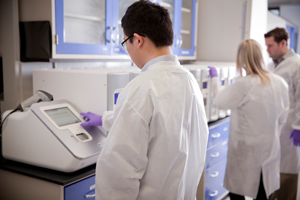Respiratory infections are more common than any other infection in the body because the respiratory tract is more susceptible to infection due to coming into contact with copious amounts of pathogens. Since numerous pathogens could be the cause of an infection, it can be difficult in diagnosing and treating patients with respiratory tract infections. The most well-known respiratory infections are influenza A and B and respiratory syncytial virus (RSV). Other viruses could include adenovirus, rhinovirus, and human metapneumovirus. These infections are costly; influenza epidemics alone, can cost between $71 billion and $167 billion.1 Non-influenza infections can be around $40 billion annually in the U.S.2

Viral infections of the respiratory tract are far more common than bacterial infections. Each year, as many as 5-20% of the U.S. population contracts influenza.3 Flu activity varies from season to season and is dependent upon how well the flu vaccine is made, how many people get the vaccine, and the virulence of the influenza strains. Anyone is able to get the flu, but people that are high risk are those who are 65 and older or those with chronic medical conditions.4 The flu can also aggravate chronic medical problems. People who get the flu tend to recover in a few days to less than two weeks, but sometimes complications can result from the flu. Sinus and ear infection are minor complications, while pneumonia is a serious complication.4 With a bacterial respiratory infection, antibiotics may be administered, but sometimes incorrect diagnose may lead to inappropriate prescribing of antibiotics that’s unnecessary. Physicians may want to look for influenza which can be treated and doesn’t need to know about rhinovirus because not much can be done past supportive care. Similar to flu, RSV can cause serious infection in certain patient populations also with complications like bronchiolitis and pneumonia. With exposure to RSV, 25-40% of children under the age of one develop bronchiolitis or pneumonia symptoms.5 RSV mostly affects young children, but also the elderly and adults with co-morbidities are also at risk of RSV. Although RSV and influenza are the main infection pathogens, adenovirus, human metapneumovirus, parainfluenza, and rhinovirus are also common viruses related to mortality and morbidity.6-9 Rhinovirus causes one billion cases of colds annually and is the most common cause of respiratory tract infections in children.9
There are many challenges that physicians and clinical laboratories need to address with diagnostic testing options. The physician’s test order changes depending on seasonality, positivity rates, clinical presentation, turnaround time, and patient history. Physicians have to decide whether to test for a broader range of pathogens or have targeted testing. Broad testing can be costly and not lead to much information, while narrow targeted testing can lead to unnecessary antibiotic use or delayed treatment. To keep costs down for both themselves and the patient, physicians must only order what is necessary to treat the patient effectively. For the patient, they want the most optimal and cost-effective testing which can be difficult when many healthcare plans now require patients to pay for more of the laboratory-based diagnostic fee. For clinical laboratories, they must have the appropriate diagnostic tools in order to cut down on the excessive use of antibiotics and unnecessary cost to the patient. Physicians and clinical laboratories are looking for testing solutions that have lower turnaround time, lower cost, and optimal patient management. Unfortunately, there isn’t one test that can cover all respiratory infections. Physicians and clinical laboratories have turned to utilizing multiple platforms but that is costly solution needing several instruments, extra staff training, more quality control testing and proficiency testing. Multiplexed molecular tests have helped cover a wider range of pathogens, but the panels of targets are fixed at fixed costs which might not suit the needs of the physicians or clinical laboratories. Physicians and laboratories sometimes need a combination of the multiplex tests to get the optimal respiratory testing, but that can be costly for the physician, clinical laboratory, and ultimately the patient.
Flexible multiplex testing platforms can provide both targeted and broad respiratory testing. Physicians and clinical laboratories have the ability to better adapt testing to tailor to the needs of their patients. Physicians and clinical laboratories would only pay for the targets selected with flexible testing. Labs can minimize quality control testing, technician training and inventory management time because all the testing would be consolidated onto one platform. Clinicians would have the capability to start with a targeted test and then expand to a broader test if the first results were negative. With less unnecessary testing being ordered, patients will then have a lower cost.
Speakers

Marilyn Mitchell, MT(ASCP)MS, Supervisor, Microbiology Laboratory, Community Regional Medical Center
As a Clinical Laboratory Scientist, Marilyn has had the opportunity to spend her early career in Chemistry and Hematology and the last 20 years specializing in Microbiology and Molecular Biology. In 2000, she completed a Master’s Degree in Molecular Biology from California State University – Fresno. Over the last 10 years, Marilyn have been published in Journal of Clinical Microbiology 2 times. Since 2012, she has been the Hematology instructor at California State University – Fresno to help prospective Clinical Laboratory Scientists get a solid background in a needed requirement. Currently, Marilyn is Microbiology Supervisor at Community Regional Medical Center in Fresno, California, where her focus is providing physicians with correct results as quickly as possible to improve patient care.

Robin Chamberland, Ph.D., Assistant Professor, Department of Pathology, Director of Microbiology Laboratory, Medical Director of Molecular Microbiology, Saint Louis University Hospital
Dr. Chamberland received her Ph.D. from the University of North Carolina School of Medicine in 2008 and completed a fellowship with the Department of Pathology and Immunology at the Washington University School of Medicine between 2009 and 2011. Dr. Chamberland is currently an Assistant Professor in the Department of Pathology and Director of the Microbiology Laboratory at the Saint Louis University Hospital. Dr. Chamberland’s research interests include antimicrobial resistance in Staphylococcus aureus, as well as bacterial toxins and their interaction with the host innate immune system, particularly in the setting of Staphylococcus aureus necrotizing pneumonia.
Who Should Attend?
- Clinical/Reference Laboratory (PhD Microbiologist, Microbiology Supervisor, Clinical Laboratory Director, Medical Technologists, Outreach Coordinators)
- Infectious Disease Physicians
- Clinical Pharmacy (Antimicrobial Stewardship Team, ID Pharmacist)
- Physicians (Private Physicians, Hospitalists, Critical Care)
Xtalks Partner
Nanosphere
Nanosphere, a Luminex Company, is dedicated to enhancing medicine by providing targeted molecular diagnostic tests that can lead to earlier disease detection, optimal patient treatment and improved healthcare economics. Our platform, the Verigene® System, enables clinicians to rapidly identify the bacteria and viruses responsible for some of the most complex, costly and deadly infectious diseases. Currently, the Verigene test menu targets infections of the bloodstream, respiratory tract and gastrointestinal tract.
Media Partner
You Must Login To Register for this Free Webinar
Already have an account? LOGIN HERE. If you don’t have an account you need to create a free account.
Create Account




